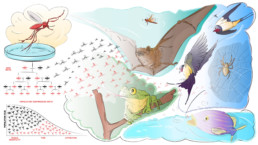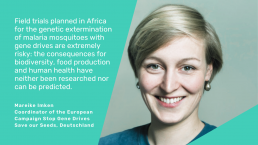IUCN debates the role of genetic engineering in nature conservation
Should nature conservationists back genetic engineering of wild species in order to counter the impact of human activity?
On Friday, 10.09.2021, the International Union for the Conservation of Nature, IUCN, at its World Congress adopted a resolution (Res. 075) at its General Assembly in Marseille, initiating a three-year position-finding process on the role of synthetic biology in relation to nature conservation. A draft resolution is to be developed and put to a vote by the next World Conservation Congress in 2024.
Applications to be discussed in this process include both the synthetic production of nature-identical products in the laboratory as well as proposals to control pests using genetic engineering in agriculture, or the genetic manipulation of insects for the purpose of disease control in open environmental systems. Most controversially, proponents and developers of genetic engineering processes even propose gene drivesas a means for nature conservation, e.g. for eradicating invasive species.
Provisions of IUCN Resolution 075
Resolution 075, entitled "Development of an IUCN position on synthetic biology in relation to conservation" establishes an inclusive and participatory process within IUCN, with the aim of developing an IUCN position on the implications of the use of synthetic biology in conservation. The resolution states that until this IUCN position is formally adopted, IUCN must remain neutral (e.g. in international fora such as the CBD) on all aspects of synthetic biology, even if new evidence emerges during the process.
By passing important amendments to Resolution 075, international conservation representatives in Marseille recognized that there exist major data and knowledge gaps as well as unsolved ethical, social, cultural and ecological issues around the technologies developed to genetically engineer wild species. Resolution 075 stipulates that these uncertainties necessitate the application of the precautionary principle and must be taken into consideration by any position the IUCN may decide to take on the topic. For this reason, particular attention in the IUCN's effort of collaborative knowledge building will be paid to identifying knowledge gaps, data deficiencies and scientific uncertainties that make it impossible to assess the impacts of existing and potential future applications of synthetic biology (including gene drives) in the context of nature conservation. In particular, open questions and challenges in ecological, conceptual, legal, socio-economic, cultural and ethical terms will be formulated and compiled. In this regard IUCN members also agreed to prioritize the perspectives, knowledge and rights of Indigenous people’s and local communities in their deliberations on these technologies during the coming 3 years.
Mareike Imken, co-ordinator of the European Stop Gene Drives campaign welcomes the IUCNs commitment to the precautionary principle and its intention to foster increased understanding and debate among its members around the use of genetic engineering technologies for nature conservation purposes.
“A broad and inclusive IUCN discussion process will be crucial to raise awareness among IUCN members that the tampering with natural evolutionary rules in the application of gene drive technology will bring about a new dimension of intervening with – and irreversibly changing - the natural world that IUCN itself means to preserve.”
The contentious negotiations around this resolution at IUCN World Congress in Marseille were divided between civil society groups calling for the IUCN to not endorse environmental releases of synthetic biology applications, and pro-gene drive proponents who advocated for synthetic biology, including gene drives, to be accepted as a tool for nature conservation. One of the gene drive proponents, IUCN member Island Conservation, advocates to use gene drives to eradicate invasive mice on islands.
Civil Society press release here
To the adopted IUCN Resolution 075 here
###
On synthetic biology
The umbrella term synthetic biology is used to describe genetic engineering techniques that rebuild, resynthesize, or alter biological components or natural processes in ways that do not occur naturally. Applications of synthetic biology can either be used exclusively in closed systems/laboratories, or also aim to use them in open natural systems, using genetic engineering to alter wild species and ecosystems - for example, via the controversial process of gene drives.
History of the motion process in the IUCN
With IUCN Resolution “WCC-2016-Res-086” adopted at its Members’ Assembly in Hawaii 2016, the IUCN was tasked to develop a policy on Synthetic Biology and Biodiversity Conservation for adoption by 2020. However, both IUCN members and members of civil society organisations criticised the way this plan was carried out. They pointed out that there currently is insufficient awareness among IUCN members about the fundamental questions that such an IUCN position would raise. In addition, the IUCN assessment report “Genetic Frontiers for Conservation” which was largely drafted by boosters of the technology was criticized to provide an insufficient basis for the vote on such a policy.
Civil Society Briefing for IUCN Delegates for IUCN World Congress in English here
Civil Society Briefing for IUCN Delegates for IUCN World Congress in French here
Civil Society Briefing for IUCN Delegates for IUCN World Congress in Spanish here
Civil Society press release on the Start of the IUCN World Congress 2021 from 4.09.2021 in English here
---
Recommended reading:
ETC Group 2019: A review of the evidence for bias and conflict of interest in the IUCN report on synthetic biology and gene drive organisms.
Testbiotech 2019: Testbiotech comment on the IUCN report “Genetic frontiers for conservation, an assessment of synthetic biology and biodiversity conservation.
Infostand beim IUCN-Weltkongress
Samstag, 04.09.2021 - Freitag, 10.09.2021 // 10:00 bis 20:30 Uhr
Ausstellungsstand "Stop Gene Drives" in der Ausstellung des IUCN-Weltkongresses, Neutral zone - Stand A 2
Online-Pressekonferenz: "Gentechnisch veränderte Ökosysteme? - Naturschutz am Wendepunkt".
Montag, 06.09.2021 - 10:15 bis 10:45 Uhr
Registrieren Sie sich, um den Link zum Pressekonferenzraum zu erhalten, indem Sie eine E-Mail an imken@saveourseeds.org schicken - Code: press conference
Exhibition stall „Stop Gene Drives“
Saturday, 4.09.2021 – Friday, 10.09.2021 // 10.00h – 22.00h CET
in the IUCN World Congress Exhibition, Neutral zone – Stall A 2
Veranstaltung: „Ökosystemtechnik und Artenausrottung durch Gentechnik?“
Samstag, 04.09.2021 - 18:30 bis 20:30 Uhr
Öffentliche Veranstaltung im Rahmen des IUCN-Weltkongresses: "Ökosystemtechnik und Artenausrottung durch Gentechnik?" Grundlegende Fragen des Naturschutzes.
Nur vor Ort; Halle: H8 - Palais de l'Europe; Raum: H8 - 2 Forêt d'Orient
European Parliament calls for ban on gene drive technology
Report on the EU' Biodiversity Strategy for 2030: Precaution prevails
9.06.2021, Berlin -The European Parliament yesterday confirmed it‘s precautionary stance towards the use of a new genetic engineering technology called gene drive.[i] In it´s report on the EU’s Biodiversity Strategy for 2030, adopted at the European Parliament’s plenary on 08.06.2021, Parliamentarians demand that „no releases of genetically engineered gene drive organisms should be allowed, including for nature conservation purposes, in line with the precautionary principle.“
Mareike Imken, coordinator of the European Stop Gene Drive Campaign welcomes this decision and comments:„With its position today, the European Parliament recognizes that this technology raises a series of scientific, regulatory, societal and ethical questions and concerns. As its use could severely harm biodiversity, the European Parliament calls to postpone any environmental releases until these questions have been addressed and settled. This is an important message that should feed into the ongoing discussions about global regulations at the next meeting of the International Union for Conservation of Nature (IUCN) in September in Marseille and those of the Convention on Biological Diversity in October in Kunming, China.“
27civil society and science organizations from across the EU had sent a letter to Parliamentarians in support of the amendment ahead of the vote. It „provides reasonable suggestions on how to implement the European Parliament’s previous position in its resolution on the 15th meeting of the Conference of Parties (COP15) to the Convention on Biological Diversity (2019/2824(RSP)“.
In that previous position, adopted in January 2020, the European Parliament had called “on the Commission and the Member States to call for a global moratorium at the COP15 on releases of gene drive organisms into nature, including field trials, in order to prevent these new technologies from being released prematurely and to uphold the precautionary principle, which is enshrined in the Treaty on the Functioning of the European Union as well as the CBD“.
Background information:
Text adopted in the report on the EU Biodiversity Strategy for 2030: Bringing nature back into our lives (2020/2273(INI)):[ii]
The European Parliament,
148. “Is concerned about the new legal, environmental, biosafety and governance challenges that might arise from the release of genetically engineered gene drive organisms into the environment, including for nature conservation purposes; acknowledges the outcome of the Ad Hoc Technical Expert Group of the Convention on Biological Diversity on gene drives and living modified fish, which raises concerns about the difficulties of predicting their behavior, assessing their risks and controlling them after release; notes that gene drive organisms could become invasive species in themselves; considers that global and EU-level risk assessment guidance materials, tools and an environmental monitoring framework, as well as clear global governance and effective mechanisms for controlling and reversing the effects of gene drive organisms, should be fully developed, and that additional research is required on the health, environmental, ecological, ethical and other implications of gene drive organisms to better understand their potential impact; considers therefore that no releases of genetically engineered gene drive organisms should be allowed, including for nature conservation purposes, in line with the precautionary principle ; “.
---------------
Download the press release here.
Letter to MEPs by civil society organisations prior to the vote.
[i] Voting results and margins for EU Biodiversity Strategy
[ii] Report on the EU Biodiversity Strategy for 2030: Bringing nature back into our lives
Europäisches Parlament fordert Verbot der Freisetzung von Gene Drive Organismen
Parlamentsbericht zur EU Biodiversitätsstrategiefür 2030 betont das Vorsorgeprinzip
Das Europäische Parlament bekräftigte in seiner Plenarabstimmung am 08.062021 seine vorsorgeorientierte Haltung gegenüber dem Einsatz eines neuen Gentechnikverfahren namens Gene Drive.[i] In ihrem Bericht zur EU-Biodiversitätsstrategie für 2030, fordern die Parlamentarier*innen, dass "im Einklang mit dem Vorsorgeprinzip keine Freisetzungen von gentechnisch veränderten Gene Drive Organismen erlaubt werden sollten, auch nicht zu Naturschutzzwecken."
Mareike Imken, Koordinatorin der europäischen Stop Gene Drive Kampagne begrüßt diese Entscheidung und kommentiert: "Mit seiner heutigen Position erkennt das Europäische Parlament an, dass die Gene Drive Technologie eine Reihe von wissenschaftlichen, regulatorischen, gesellschaftlichen und ethischen Fragen und Bedenken aufwirft. Da ihr Einsatz die biologische Vielfalt stark beeinträchtigen könnte, fordert das Europäische Parlament, jegliche Freisetzung in die Umwelt aufzuschieben, bis diese Fragen geklärt sind. Dies ist eine wichtige Botschaft, die in die laufenden Diskussionen zur globale Regulierung der Technologie auf dem nächsten Treffen der Internationalen Union für Naturschutz (IUCN) im September in Marseille und in die laufenden Vor-Verhandlungen zur COP 15 des Übereinkommens über die biologische Vielfalt im Oktober einfließen sollte."
27 zivilgesellschaftliche und wissenschaftliche Organisationen aus der gesamten EU hatten vor der Abstimmung einen Brief an die Parlamentarier*innen geschickt, um den Passus zu unterstützen. Er enthalte „vernünftige Vorschläge dafür, wie die frühere Position des Europäischen Parlaments in der Entschließung zur 15. Tagung der Konferenz der Vertragsparteien (COP15) des Übereinkommens über die biologische Vielfalt (2019/2824(RSP)) umgesetzt werden kann".
In dieser früheren Position, die im Januar 2020 verabschiedet wurde, hatte das Europäische Parlament die EU-Kommission und die EU-Mitgliedstaaten dazu aufgefordert, „auf der COP15 ein globales Moratorium für Freisetzungen von Gene Drive-Organismen in die Natur, einschließlich Feldversuchen, zu fordern, um eine verfrühte Freisetzung dieser neuen Technologien zu verhindern und das Vorsorgeprinzip zu wahren, das sowohl im Vertrag über die Arbeitsweise der Europäischen Union als auch in der CBD verankert ist.“
Hintergrundinformationen:
Dies ist der nun angenommene Passus, der im Bericht über das Thema „EU-Biodiversitätsstrategie für 2030: Mehr Raum für die Natur in unserem Leben“(2020/2273(INI)) durch das Plenum des Europäischen Parlaments angenommen wurde. [ii]:
Das Europäische Parlament,
148. ist besorgt über die neuen Herausforderungen in den Bereichen Recht, Umwelt, biologische Sicherheit und Regierungsführung, die sich aus der Freisetzung von durch Genantrieb veränderten Organismen in die Umwelt, auch zu Naturschutzzwecken, ergeben könnten; nimmt den Bericht der Ad-hoc-Sachverständigengruppe des Übereinkommens über die biologische Vielfalt zu durch Genantrieb veränderten Organismen und lebenden veränderten Fischen zur Kenntnis, in dem Bedenken hinsichtlich der Schwierigkeiten geäußert werden, ihr Verhalten vorherzusagen, ihre Risiken zu bewerten und sie nach der Freisetzung zu kontrollieren; stellt fest, dass durch Genantrieb veränderte Organismen selbst zu invasiven Arten werden könnten; ist der Ansicht, dass auf globaler und EU-Ebene Leitfäden zur Risikobewertung, Instrumente und ein Rahmen für die Umweltüberwachung sowie eine klare globale Steuerung und wirksame Mechanismen zur Kontrolle und Umkehrung der Auswirkungen von durch Genantrieb veränderten Organismen vollständig entwickelt werden sollten und dass zusätzliche Forschung zu den gesundheitlichen, umweltrelevanten, ökologischen, ethischen und anderen Auswirkungen von durch Genantrieb veränderten Organismen erforderlich ist, um ihre potenziellen Auswirkungen besser zu verstehen; ist daher der Auffassung, dass im Einklang mit dem Vorsorgeprinzip keine Freisetzungen von durch Genantrieb veränderten Organismen zugelassen werden sollten, auch nicht zu Naturschutzzwecken.
Pressemitteilung hier herunterladen.
Verbändebrief an MEPs vor der Abstimmung.
[i] Abstimmungsergebnisse des Europaparlaments für Paragraphen der EU Biodiversitätsstrategie vom Plenum am 08.09.2021
[ii] Europäisches Parlament: Bericht über das Thema "EU Biodiversitätsstrategie für 2030: Mehr Raum für Natur in unserem Leben."
World Malaria Day: Do we need gene drives to fight malaria?
Gene drive technology carries high risks. Yet it is being promoted by the Bill & Melinda Gates Foundation as a solution to malaria. On the occasion of World Malaria Day, the Stop Gene Drives campaign is launching a project that presents different perspectives on the issue of malaria control and highlights alternative, possibly less risky approaches and innovations to combat malaria.
Infectious diseases such as malaria, dengue fever and Lyme disease are transmitted to humans by so-called vectors, such as mosquitoes or ticks. In the case of malaria, the pathogen and thus the disease is spread exclusively by Anopheles mosquitoes. A global program of malaria control has so far helped to roll back the disease in many regions of the world. Already 38 countries have been certified malaria-free, but there remain 86 countries where malaria control has not been adequately implemented, resulting in several hundred thousand deaths.
This is where the discussion of Gene Drive technology comes into play. Mosquitoes are genetically modified in the laboratory using a process known as CRISPR/Cas so that they pass on a new trait to all their offspring, even if that trait causes the population or the entire species to become extinct. Gene drive mosquitoes produced in this way are expected to massively reduce the number of Anopheles mosquitoes in Africa and thus prevent the transmission of malaria. Gene drives are therefore being promoted as an effective technological solution to combat malaria.
Mareike Imken, coordinator of the Stop Gene Drive campaign, explains in a short interview what concerns there are about the use of gene drive technology and what the goal of the European Stop Gene Drive campaign is. (To the interview)
A leading role in the development of such gene drives is played by the international research consortium Target Malaria, which is largely funded by the Bill & Melinda Gates Foundation. In an interview with us, Dr. Andreas Wulf of Medico International explains their influence on global health policy and the selection of priorities and measures, including those to combat malaria, that are influenced by them. (To the interview)
Target Malaria's plans to use gene drives have already reached the stage where the first projects have been launched in Africa, including Burkina Faso. In July 2019, Target Malaria conducted its first field tests in Burkina Faso using genetically modified sterile mosquitoes that did not yet carry Gene Drive. These trials were considered a precursor to the release of Gene Drive mosquitoes in a later phase of the project. These and subsequent tests have met with resistance from parts of the population in Burkina Faso, as Ali Tapsoba, human rights activist, explains in his interview with us. (To the interview) He is the spokesperson for civil society resistance to the release of Gene Drives in Burkina Faso. Treatment and profilaxis with Artemisia teas grown in Africa are among the measures he would prefer over the use of Gene Drive technology. However, the World Health Organization (WHO) warns against this. Internationally renowned professor Pamela Weathers of Worcester Polytechnic Institute explains how effective and safe Artemisia tea infusions are for treating or preventing malaria in her interview with us. (To the interview)
Burkina Faso has, according to epidemiologist Dr. Sory, a strong strategy to combat malaria. A cocktail of different measures is needed to fight this disease and decrease other diseases at the same time. Better drainage systems, awareness raising and access to health care are just a few points raised in the interview. (To the interview)
Artemisinin is a component derived from the Artemisia plant and present in most anti-malarial drugs nowadays. Lucile Cornet-Vernet and Arnaud Nouvion from the Maison de l'Artemisia, talk about the potential to use the plant as tea as a preventive and curative method for malaria. Furthermore, they make clear that final clinical studies are needed to get the plant approved by the WHO. (To the interview with Lucile and Arnaud)
Interview with Mareike Imken
Gene drive technology carries high risks. Yet it is being promoted by the Bill & Melinda Gates Foundation as a solution to malaria. On the occasion of World Malaria Day, the Stop Gene Drives campaign is launching a project that presents different perspectives on the issue of malaria control and presents alternative, possibly less risky approaches and innovations to combat malaria.
In this interview Mareike Imken, coordinator of the European Stop Gene Drives Campaign explains the reasoning behind this project.
Ms. Imken, why does the Stop Gene Drive Campaign provide information about malaria control options?
As part of the Stop Gene Drive campaign, we want to help decision-makers and the general public to classify the risks and potential of gene drive technology in contrast to alternative measures and innovations for malaria control. To this end, we will present different approaches and perspectives on malaria control throughout 2021.
What does Gene Drive technology have to do with malaria?
Gene Drive technology aims to genetically modify or eradicate the malaria-carrying Anopheles mosquito. The Bill & Melinda Gates Foundation in particular is pushing ahead into this technology as part of its "Target Malaria" program. The first field trials could take place in Burkina Faso, Mali, Uganda and Ghana in the next 5-10 years. But such release trials carry high risks: Even small-scale release trials could result in irreversible genetic modification or eradication of wild mosquito populations. However, the consequences for the environment, biodiversity, food production, and human health are neither studied nor foreseeable.
What is the goal of the Stop Gene Drive campaign?
With the Stop Gene Drive campaign, we want to stimulate a broad social debate about the fundamental intervention in nature that would be associated with the application of gene drive technology. We need time for such a fundamental debate instead of being presented with a fait accompli in the next few years. That is why a broad alliance of civil society organizations in the EU and worldwide is calling for a global moratorium on release trials of genetically modified Gene Drive mosquitoes. Such a moratorium would buy humanity time to meet minimum requirements for the use of such a high-risk technology. That is, model the risks of the technology in the laboratory and weigh them against the risks and benefits of alternative measures. In addition, establish the international regulations and decision-making procedures that have been lacking to date.
--
These are the interviews on the topic held so far with the following experts:
Andreas Wulf, physician and expert for global health policy at Medico International in the Berlin office, provides his views on the role of the Bill & Melinda Gates Foundation in international health policy and his outlook on necessary conditions for the implementation of the human right to health in Africa.
Click here for the interview
Ali Tapsoba de Goamma, human rights activist, and spokesman for an alliance in Burkina Faso against the release of Gene Drive mosquitoes in his home country, on the malaria control measures implemented so far and the attitude of the local population towards the planned field trials with Gene Drive mosquitoes.
Click here for the interview
Pamela J. Weathers, professor and researcher at Worcester Polytechnic Institute in Massachusetts, USA, on the efficacy and controversial safety of Artemisia tea infusions for treating or preventing malaria.
Click here for the interview
Arnaud Nouvion, consultant and Lucile Cornet-Vernet, co-founder of La Maison de L’Artémisia, describe the potential benefits of the Artémisia plant and state that more funding is needed to conduct clinical studies, proving once and for all that the plant is a great tool in the fight against malaria.
Click here for the interview
More interviews to follow.
Welt-Malaria-Tag: Braucht es Gene Drives zur Malariabekämpfung?
Infektionskrankheiten wie Malaria, Dengue-Fieber und Borreliose werden von sogenannten Vektoren wie Mücken oder Zecken auf den Menschen übertragen. Im Fall von Malaria wird der Erreger und damit die Krankheit ausschließlich durch Anophelesmücken verbreitet. Ein globales Programm der Malariakontrolle hat bisher dazu beigetragen, die Krankheit in vielen Regionen der Welt zurückzudrängen.
Bereits 38 Länder sind als malariafrei zertifiziert, aber es verbleiben noch immer 86 Länder, in denen die Malariakontrolle nicht ausreichend umgesetzt werden konnte. Das hat mehrere Hunderttausend Tode zur Folge.
Mit Gene Drives Malaria bekämpfen?
Hier kommt die Diskussion über die Gene Drive Technologie ins Spiel. Mücken werden im Labor mithilfe des sogenannten CRISPR/Cas Verfahrens gentechnisch so verändert, dass sie eine neue Eigenschaft an sämtliche Nachkommen weitervererben. Und das auch, wenn diese Eigenschaft dazu führt, dass die Population oder die ganze Art ausstirbt. Auf diese Weise erzeugte Gene Drive Mücken sollen die Zahl der Anophelesmücken in Afrika massiv reduzieren und somit die Übertragung der Malaria verhindern. Gene Drives werden deshalb als effektive technologische Lösung zur Bekämpfung von Malaria propagiert.
Kritische Stimmen
Nutzung der Gene Drive Technologie
Welche Bedenken es bezüglich der Nutzung der Gene Drive Technologie gibt und welches Ziel die europäische Stop Gene Drive Kampagne verfolgt, erklärt Mareike Imken im Kurzinterview. Sie ist die Koordinatorin der Stop Gene Drive Kampagne.
Zum Interview mit Mareike Imken
Einfluss der Bill & Melinda Gates Foundation auf Maßnahmen zur Malariabekämpfung
Eine führende Rolle bei der Entwicklung derartiger Gene Drives spielt das internationale Forschungskonsortium Target Malaria, das zum großen Teil aus Mitteln der Bill & Melinda Gates Foundation finanziert wird. Deren Einfluss auf die globale Gesundheitspolitik und die durch sie beeinflusste Auswahl von Prioritäten und Maßnahmen auch zur Malariabekämpfung erklärt uns Dr. Andreas Wulf von Medico international im Interview mit uns.
Zum Interview mit Dr. Andreas Wulf
Widerstand gegen die Freisetzung von Gene Drives in Burkina Faso
Die Pläne von Target Malaria zum Einsatz von Gene Drives sind schon so weit, dass erste Modellprojekte in Afrika, darunter auch in Burkina Faso, gestartet wurden. Im Juli 2019 führte Target Malaria in Burkina Faso erste Freilandtests mit gentechnisch veränderten sterilen Mücken durch, die noch keinen Gene Drive trugen. Diese Versuche galten als Vorstufe zur Freisetzung von Gene Drive Mücken in einer späteren Projektphase. Diese und nachfolgende Test stoßen in Teilen der Bevölkerung in Burkina Faso auf Widerstand. Das erklärt Ali Tapsoba, Menschenrechtsaktivist, in seinem Interview mit uns. Ali Tapsoba ist der Sprecher des zivilgesellschaftlichen Widerstands gegen die Freisetzung von Gene Drives in Burkina Faso.
Behandlung von Malaria mit Artemisia Tee-Aufgüssen
Die Behandlung mit Artemisia-Tees aus afrikanischem Anbau zählt zu den Maßnahmen, die Ali Tapsoba gegenüber der Nutzung der Gene Drive Technologie bevorzugen würde. Davor warnt jedoch die Weltgesundheitsorganisation WHO. Wie wirksam und sicher Artemisia Tee-Aufgüsse zur Behandlung oder Vorbeugung von Malaria sind, erklärt die internationale renommierte Professorin Pamela Weathers des Worcester Polytechnic Institutes in ihrem Interview mit uns.
Zum Interview mit Pamela Weathers




